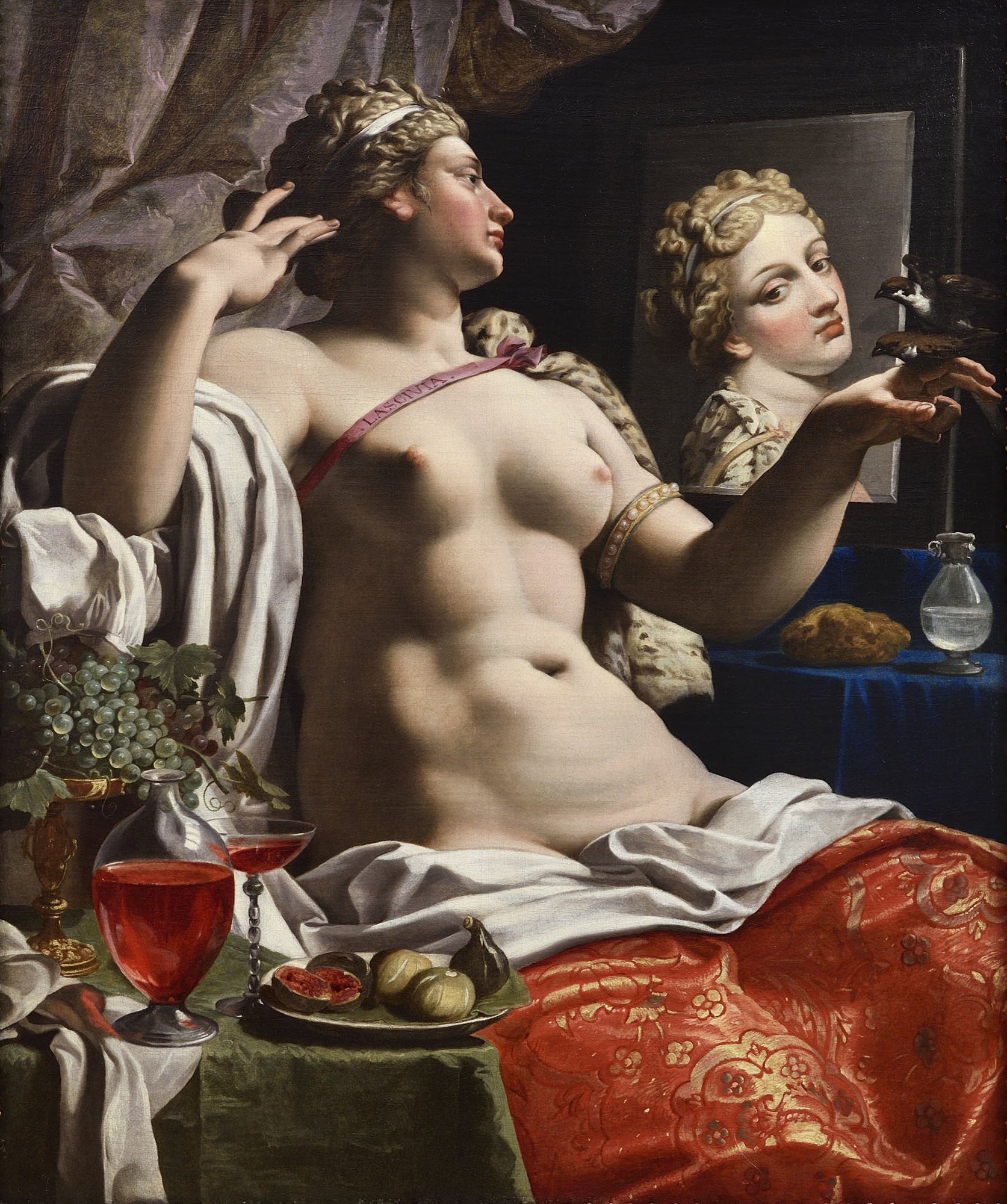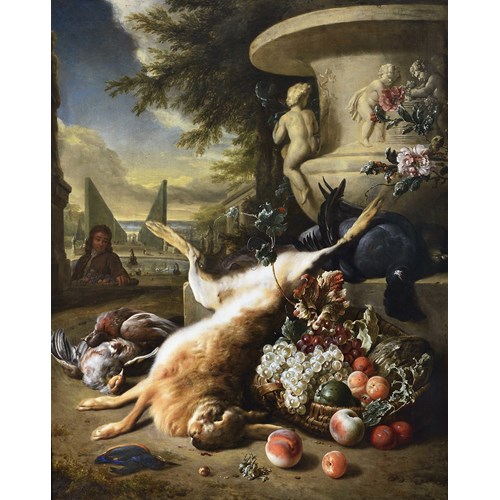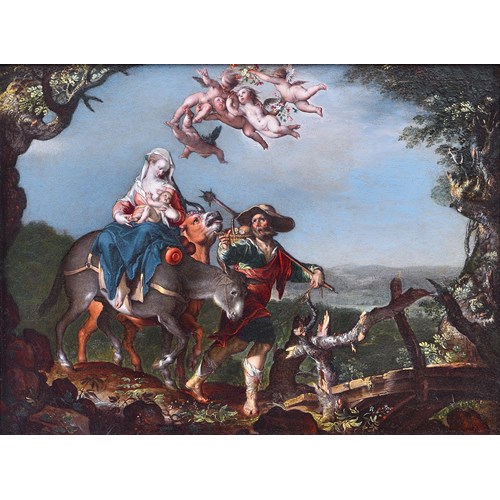Marketplace
Lascivia
Abraham Janssens I
Lascivia
Date 1618
Epoque 1600-1750, 17th century
Origine Belgium
Medium Oil on canvas
Dimension 118.2 x 98.4 cm (46¹/₂ x 38³/₄ inches)
Lascivia can be dated to circa 1618, by comparison with a second version of Lascivia, in the Musée Royaux des Beaux-Arts, Brussels, Inv. no. 6592, which however lacks the exquisite still life elements seen on the table at the lower left of the present composition as well as the glass and bread placed on the table beneath the mirror. The recent cleaning of the painting has removed old over-paint which was added to mask the second copulating sparrow perched on Lascivia’s raised left hand. Further comparisons can be made with Janssens' Diana and Nymphs, (c. 1617; Kassel, Gemaldegalerie Alte Meister, Inv. no. GK83) and Olympus, (Munich, Alte Pinakothek, Inv. no. 4889). These, and the present work, all attest to Janssens' changing style, moving away from an earlier Caravaggesque tenebrism towards a greater classicism, which can be seen in his work as early as 1612.
The monumental figure seen in this composition, so clearly identified by the emblazoned “LASCIVIA” seen on the strap of her mantle, harkens back to examples from Renaissance Italy, while the still life elements in the picture reflect developments in Flanders by Janssens' contemporaries Osias Beert, Jacob van Hulsdonck and Frans Snyders, among others. From the Middle Ages onwards artists such as Giorgione, Veronese, Titian, and Rubens had focused on images of Venus and other allegorical figures to portray the seductive beauty of the female body. Such figures would often personify positive concepts such as Veritas (truth), Sapientia (Wisdom), and Prudentia (Prudence), or negative ones such as Superbia (Arrogance), Vantias (Vanity) or Lascivia (Wantonness). Here the image of Lascivia clearly combines the concepts of vanity, sensuality and erotic love. The seductive woman here looks at herself in the mirror, a traditional symbol of vanity, revealing the falseness of the external world. However, unlike earlier northern painters, Janssens and other artists of the period were looking for a new more secular pictorial language, one that retained the necessary didactic character, while revealing a softer and less intense moralizing tone.
Abraham Janssens was also known as Janssens Van Nuyssen, a name he adopted from his mother's family in order to distinguish himself from other members of the Janssens family of contemporary artists. He was a pupil of Jan Snellinck, and he was first recorded when admitted as a teaching master into the Guild of St. Luke in 1601, and in 1607 he became dean of the master-painters. He married in 1602, and his daughter, Anna, married Jan Breughel the younger, the son of "Velvet" Breughel, and the second of his sons, named Abraham like his father, became a painter, and was admitted a member of the Guild of Painters in 1636. His earliest pictures are characteristic of the northern Mannerist tradition, however his stylistic development indicates that he was in Rome between 1598 and 1601 and probably revisited the city sometime between 1602 and 1610. Beginning about 1610 the influence of the dramatic lighting and vigorous modeling of Caravaggio and the Roman Baroque school becomes clearly manifest in his work. His mature style would become more classical in expression, and he became known as the leading exponent of the classical Baroque style in Flanders during the early 17th century.
Janssens was a contemporary of Rubens, and until the appearance of that great master, was considered the best historical painter of his time. The styles of the two artists are not dissimilar in both skill in drawing and the creation of bold compositions, often employing nude figures. He was a master of chiaroscuro, with a taste for strong contrasts of light and shade, which he frequently explored in scenes lit by candle or torch. The artist was highly respected in Antwerp, spoken of in terms of friendship and affection by other artists, and recognized as a man of great genius, taking a high position in the very first rank. The best of Janssens' pictures are to be seen at Antwerp, especially in the churches of the Carmelites and St. Charles, and in the cathedral, the painting of The Entombment in the Carmelite church being one of his very finest productions. There are three important paintings by him in the Antwerp Museum, two in the cathedral at Ghent, one in the cathedral at Bruges, a remarkable mythological scene representing Venus and Jupiter in Brunswick, and a fine picture of St. Cecilia at Cologne. Other galleries containing works by this important artist are those of Berlin, Brussels, Cassel, and Vienna. In at least two of his pictures he worked in collaboration with Snyders. The flowers and fruit in his picture of Pomona at Berlin, and the animals in his representation of Atalanta in the same gallery were painted by his friend, Snyders. His works were enormously popular and many of his pictures were engraved.
The monumental figure seen in this composition, so clearly identified by the emblazoned “LASCIVIA” seen on the strap of her mantle, harkens back to examples from Renaissance Italy, while the still life elements in the picture reflect developments in Flanders by Janssens' contemporaries Osias Beert, Jacob van Hulsdonck and Frans Snyders, among others. From the Middle Ages onwards artists such as Giorgione, Veronese, Titian, and Rubens had focused on images of Venus and other allegorical figures to portray the seductive beauty of the female body. Such figures would often personify positive concepts such as Veritas (truth), Sapientia (Wisdom), and Prudentia (Prudence), or negative ones such as Superbia (Arrogance), Vantias (Vanity) or Lascivia (Wantonness). Here the image of Lascivia clearly combines the concepts of vanity, sensuality and erotic love. The seductive woman here looks at herself in the mirror, a traditional symbol of vanity, revealing the falseness of the external world. However, unlike earlier northern painters, Janssens and other artists of the period were looking for a new more secular pictorial language, one that retained the necessary didactic character, while revealing a softer and less intense moralizing tone.
Abraham Janssens was also known as Janssens Van Nuyssen, a name he adopted from his mother's family in order to distinguish himself from other members of the Janssens family of contemporary artists. He was a pupil of Jan Snellinck, and he was first recorded when admitted as a teaching master into the Guild of St. Luke in 1601, and in 1607 he became dean of the master-painters. He married in 1602, and his daughter, Anna, married Jan Breughel the younger, the son of "Velvet" Breughel, and the second of his sons, named Abraham like his father, became a painter, and was admitted a member of the Guild of Painters in 1636. His earliest pictures are characteristic of the northern Mannerist tradition, however his stylistic development indicates that he was in Rome between 1598 and 1601 and probably revisited the city sometime between 1602 and 1610. Beginning about 1610 the influence of the dramatic lighting and vigorous modeling of Caravaggio and the Roman Baroque school becomes clearly manifest in his work. His mature style would become more classical in expression, and he became known as the leading exponent of the classical Baroque style in Flanders during the early 17th century.
Janssens was a contemporary of Rubens, and until the appearance of that great master, was considered the best historical painter of his time. The styles of the two artists are not dissimilar in both skill in drawing and the creation of bold compositions, often employing nude figures. He was a master of chiaroscuro, with a taste for strong contrasts of light and shade, which he frequently explored in scenes lit by candle or torch. The artist was highly respected in Antwerp, spoken of in terms of friendship and affection by other artists, and recognized as a man of great genius, taking a high position in the very first rank. The best of Janssens' pictures are to be seen at Antwerp, especially in the churches of the Carmelites and St. Charles, and in the cathedral, the painting of The Entombment in the Carmelite church being one of his very finest productions. There are three important paintings by him in the Antwerp Museum, two in the cathedral at Ghent, one in the cathedral at Bruges, a remarkable mythological scene representing Venus and Jupiter in Brunswick, and a fine picture of St. Cecilia at Cologne. Other galleries containing works by this important artist are those of Berlin, Brussels, Cassel, and Vienna. In at least two of his pictures he worked in collaboration with Snyders. The flowers and fruit in his picture of Pomona at Berlin, and the animals in his representation of Atalanta in the same gallery were painted by his friend, Snyders. His works were enormously popular and many of his pictures were engraved.
Date: 1618
Epoque: 1600-1750, 17th century
Origine: Belgium
Medium: Oil on canvas
Signature: Inscribed on strap of figure’s mantle: LASCIVIA
Dimension: 118.2 x 98.4 cm (46¹/₂ x 38³/₄ inches)
Provenance: With Newhouse Galleries, New York;
Mr. and Mrs. Donald Bauchner, to 2001;
Private collection
Plus d'œuvres d'art de la Galerie









